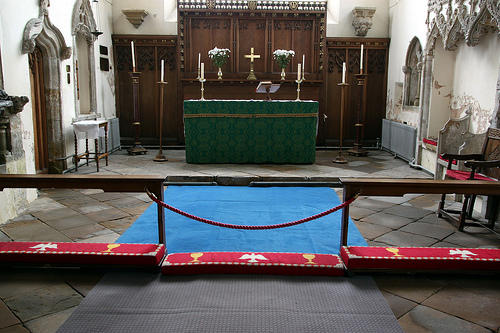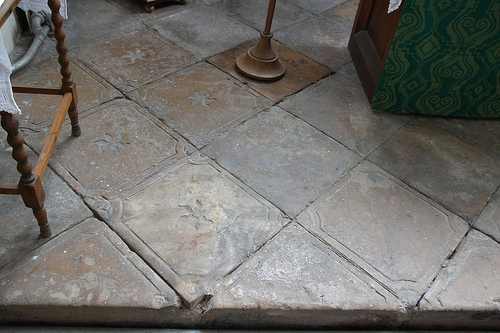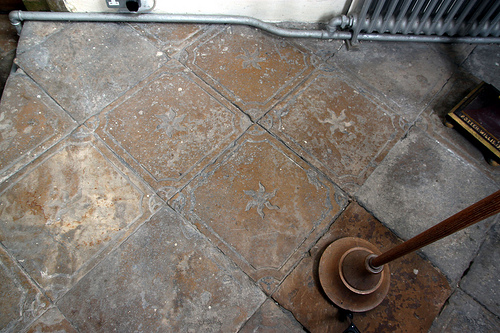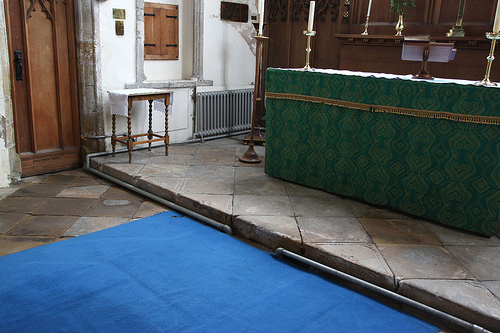Medieval History
Medieval stone pavements in English chancels are something of a rarity. In fact medieval chancel floors are a rarity, for many were destroyed either by post-Reformation burials, or swept away in the nineteenth century. Under the influence of the Ecclesiologists in Victorian restorations, medieval floor levels were destroyed to admit ranks of steps for elevated altars. Altars elevated on steps were considered more 'correct' and medieval. So I was surprised to see a well-preserved fourteenth century stone pavement in the chancel at Laxton in Nottinghamshire.

The pavement, formed from square stone sets or lozenges, covers about half of the chancel floor, including the sanctuary. The western half of the chancel between the choir stalls is covered by Victorian encasstics. Though badly worn and affected by damp, some of the sanctuary slabs still have their original decoration on them. Each has a centrally placed estoile and and is bordered with a narrow line. At the point where for slabs meet, a semicircle in each slab forms part of a decorative quaterfoil. It is a striking, but simple, design. Presumably the levels are the original medieval levels and rather than being raised on a rank of steps or footpace, here we have evidence that the medieval high altar here, was simply raised on a single step above the chancel pavement.



What surprises me about this pavement is that despite it's rarity and importance, nobody seems to have noticed it before. Pevsner doens't mention it, neither does the listed building record, nor even Cox in his Nottinghamshire Churches. Sadly the pavement has been damaged, principally by the modern heating system. The blue carpet covers a large modern metal grille and cast iron pipes makes a fill circuit of the sanctuary.
- Looking Down (at Medieval Floors)
Quite often when we visit church buildings we are so busy looking up at the soaring architecture and the fine roofs, that we sometimes forget to look at the floors. St Nicholas, Salthouse on the north Norfolk coast, has a floor that...
- Aumbry Door
Many of our churches still retain the evidence of aumbries, the secure lockers that served as the repository for valuables before the invention of the safe. They are a common feature let into the side walls beside both...
- Another Atmospheric Interior
If you thought Nettlecombe had atmosphere, well Molland church on Exmoor, in Devon, has even more. It is one of those churches that the Victorian's forgot and wasn't subjected to a drastic restoration in the nineteenth century. Consequently...
- It's Amazing What You Find Under The Floor.
According to John Throsby in his new addition of Thoroton's The Antiquities of Nottinghamshire, when the floor of the chancel at Mattersey church in Nottinghamshire was replaced in the 1790s they discovered two pieces of 'very ancient'...
- Beware The Ides Of March
The Norman chancel arch at Glympton in Oxfordshire has the following interesting and tantalising inscription carved on its jamb: 'Dedicatio hujus templi Idus Martii' i.e. 'this temple was dedicated on the Ides (15th) of...
Medieval History
Medieval pavement
Medieval stone pavements in English chancels are something of a rarity. In fact medieval chancel floors are a rarity, for many were destroyed either by post-Reformation burials, or swept away in the nineteenth century. Under the influence of the Ecclesiologists in Victorian restorations, medieval floor levels were destroyed to admit ranks of steps for elevated altars. Altars elevated on steps were considered more 'correct' and medieval. So I was surprised to see a well-preserved fourteenth century stone pavement in the chancel at Laxton in Nottinghamshire.

The pavement, formed from square stone sets or lozenges, covers about half of the chancel floor, including the sanctuary. The western half of the chancel between the choir stalls is covered by Victorian encasstics. Though badly worn and affected by damp, some of the sanctuary slabs still have their original decoration on them. Each has a centrally placed estoile and and is bordered with a narrow line. At the point where for slabs meet, a semicircle in each slab forms part of a decorative quaterfoil. It is a striking, but simple, design. Presumably the levels are the original medieval levels and rather than being raised on a rank of steps or footpace, here we have evidence that the medieval high altar here, was simply raised on a single step above the chancel pavement.



What surprises me about this pavement is that despite it's rarity and importance, nobody seems to have noticed it before. Pevsner doens't mention it, neither does the listed building record, nor even Cox in his Nottinghamshire Churches. Sadly the pavement has been damaged, principally by the modern heating system. The blue carpet covers a large modern metal grille and cast iron pipes makes a fill circuit of the sanctuary.
- Looking Down (at Medieval Floors)
Quite often when we visit church buildings we are so busy looking up at the soaring architecture and the fine roofs, that we sometimes forget to look at the floors. St Nicholas, Salthouse on the north Norfolk coast, has a floor that...
- Aumbry Door
Many of our churches still retain the evidence of aumbries, the secure lockers that served as the repository for valuables before the invention of the safe. They are a common feature let into the side walls beside both...
- Another Atmospheric Interior
If you thought Nettlecombe had atmosphere, well Molland church on Exmoor, in Devon, has even more. It is one of those churches that the Victorian's forgot and wasn't subjected to a drastic restoration in the nineteenth century. Consequently...
- It's Amazing What You Find Under The Floor.
According to John Throsby in his new addition of Thoroton's The Antiquities of Nottinghamshire, when the floor of the chancel at Mattersey church in Nottinghamshire was replaced in the 1790s they discovered two pieces of 'very ancient'...
- Beware The Ides Of March
The Norman chancel arch at Glympton in Oxfordshire has the following interesting and tantalising inscription carved on its jamb: 'Dedicatio hujus templi Idus Martii' i.e. 'this temple was dedicated on the Ides (15th) of...
